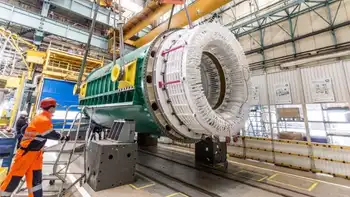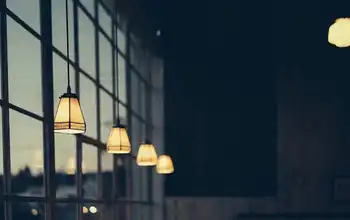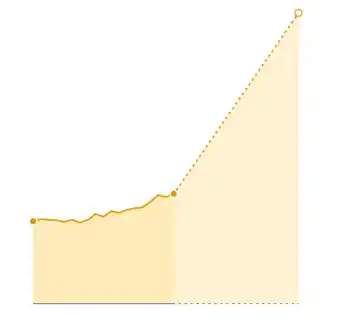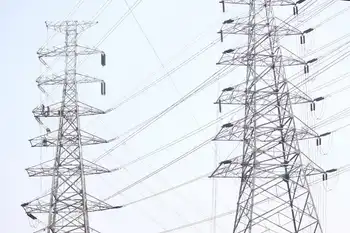“Pioneer” has high hopes for wind turbine
Now in the midst of his cutting-edge project, he hasn't lost faith in his primary objective.
"We're learning as we go," he said. "It's an education I didn't really want. But that's what happens when you are the first to do anything."
Kananen may be the first in the area to install a vertical-axis wind turbine. He's been told he's the first in the nation to test the particular 10-kilowatt model he installed near his home. In fact, it's supposedly only the second in the world, the other having been erected in Canada.
The "reluctant pioneer" is sold on the theory of the vertical-axis wind turbine, or VAWT, design. What sets his apart from a standard wind turbine is the way its five air foil panels rotate around the main shaft. Each blade is shaped like an airplane wing, with push from the front and lift in the back.
Rising roughly 60 feet into the air, it resembles a giant egg beater.
Overall, VAWTs are typically smaller and considered less of an eyesore than their horizontal counterparts. They're also touted as being more efficient, particularly at low levels, and much quieter, if not silent.
"It's a hell of a design - really simple, nothing complicated at all," Kananen said. "They're going to be the wave of the future."
Unfortunately, Kananen's "wave of the future" has encountered a glitch. Erected in August, it's still not producing as advertised. Kananen has yet to determine the source of the problem, but he thinks it originates from one of three factors: the inverters, the generator or, less likely, his connection to Beartooth Electric Co-op.
He's sent the inverters back to be reprogrammed, and he expects he'll be sending the generator back for a replacement. Both are under warranty.
Kananen's quest for alternative power began last January when Beartooth raised rates and his power bill skyrocketed to $900.
Heat for the family's home was already supplied by a geothermal unit, but the Boyd family's electricity usage - between home, shop and agricultural operation - averages 3,500 kilowatts each month. That's more than double the typical residential requirement.
After researching options, he narrowed his focus on wind energy.
"Solar was too expensive, based on what I was trying to accomplish," he said.
At first, even wind turbines seemed out of the question. He couldn't find anything to meet his needs for less than $1 million. Then he stumbled onto the 10-kilowatt vertical axis model manufactured by Shanghai Aeolus Windpower Technology.
In March, he ordered the unit through Andy Richards, owner of the Cody, Wyo.-based Advanced Energy Technology and the local distributor for the SAWT turbines. By midsummer, all the pieces and parts had arrived.
Kananen and Richards poured the 4-foot-thick concrete pad, erected the pole and manipulated two cranes to hold the pole steady as they lifted the generator and turbine in place.
"Finding a non-windy day to do it was tough," Kananen said.
All told, he figures he has $42,000 into the equipment and another $8,000 in the "do-it-yourself" installation. Between federal and state tax credits totaling 40 percent, he calculates his cost at about $30,000.
"My thinking is, if this thing works and it catches on, for the price of a car it'll produce more than my house uses," he said.
Despite the snafus, it's apparent that Richards of Cody is sold on the vertical axis design, although he also deals in traditional wind turbines. Working doggedly with Kananen to resolve the problem, Richards admits it's not been a moneymaker.
"It's like tuning an engine to get to its most productive (level)," he said. "It's a bit of a challenge, but, once we get it there, it'll be a hugely producing machine."
Within a few days, depending on delivery and weather, Richards will install three 4-kilowatt vertical-axis units on a property in the Billings area. Unlike Kananen's five-panel unit, these wind turbines are a helix design that evolved from a 1920s helicopter prototype.
The helix design works on a shorter pole, which makes it more acceptable in areas zoned with height restrictions. The turbines are powered by three skewed blades that capture just about any breeze, he said.
While Kananen continues tinkering on the turbine, he's also hoping for changes in Beartooth Co-op's net-metering policy.
Once he begins producing more electricity than he needs, he is eligible for credit at the end of each month. But, as policy stands now, he would lose any excess credit at the end of the year, credit he'd rather apply toward his electricity bill or donate to the Roberts School.
Kananen also speaks of another concern. He figures that without the do-it-yourself installation, the total cost could easily run in the $100,000 range. And to operate entirely off the grid would mean another $10,000 in batteries.
"The problem I see with this unit, the average guy just can't afford it," he said.
But, according to his calculations, it should ultimately pencil out for him.
When, or if, the turbine produces as advertised, it will take six to seven years for him to break even. Considering the turbine has a 20-year life, that's 13 years of electricity at no cost, he said. At this point, he'd like nothing better than to begin recouping that benefit.
"Note to self: Unless you're really into learning, never be the first guy to try something," he said, laughing.
Related News

Canadian nuclear projects bring economic benefits
TORONTO - The 13-year Major Component Replacement (MCR) project being undertaken as part of Bruce Power's life-extension programme will inject billions of dollars into Ontario's economy, a new report has found. Meanwhile, the major project to refurbish Darlington unit 2 remains on track for completion in 2020, Ontario Power Generation (OPG) has announced.
The Ontario Chamber of Commerce (OCC) said its report, Major Component Replacement Project Economic Impact Analysis, outlines an impartial assessment of the MCR programme. The report was commissioned by Bruce Power.
"Our analysis shows that Bruce Power's MCR project is a fundamental contributor to the Ontario economy. More broadly, the…





